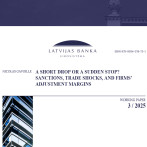Latvian exports continue to grow
Albeit the overall demand in external markets is low, in October 2012 Latvian external trade of goods retained remarkable annual growth rate because of the competitiveness regained during the crisis years. The annual export growth was at 22.6%, which is almost twice that of imports (annual growth at 12.1%).
Just as in 2011, this year as well sees a rise in Latvia’s exports of goods that is among the highest in the European Union. In the first 10 months of the year, exports have grown 13.8% year-on-year, posting a rise in all groups of goods with the exception of the products of chemical industry and related branches and transport vehicles. The situation continued to improve in October and the annual growth was positive in all groups of export goods.
According to the data of the World Trade Organization and "Eurostat", Latvia’s market shares in global exports continued to grow, posting a notable rise even in those trade partners of the European Union (EU) where the external demand was down (Denmark, Great Britain). The expansion of market shares continued in the Russian market and the rapidly growing economies, e.g., India, China, as well as some other Asian countries (UAE, Azerbaijan, Kazakhstan etc.).
The diversified structures of Latvian exports and the competitiveness of exporters could help Latvia to make its way into less developed markets, compensating for the drop in goods demand in some EU countries and ensuring export growth even in very complicated external circumstances.
The economic problems of the euro area countries, however, have had an impact on Latvian business and consumer confidence. The data published by the European Commission indicate that in October the evaluation of export order volumes deteriorated and the confidence data for the fourth quarter likewise point to a deterioration of Latvian producer confidence both with regard to trends in production volume changes and export order volumes and competitiveness evaluations outside the country. Surveys also indicate, however, that the Latvian exporters are more optimistic in their assessment of both the present and future than those who are not in the export business. Thus, the economic complications and slow growth notwithstanding, export opportunities to the euro area continue to have a favourable effect on the Latvian economy.
Just as Latvian pig farmers have managed to find other markets (mostly in Estonia, Lithuania and Poland) and are not suffering great losses overall since Russia introduced a ban on livestock from the EU, the ban on taking livestock out of Latvia in subsequent months did not have a substantial effect on total exports because it amounts to only about 0.5% of Latvia’s total goods exports.
Albeit the income generated by exports have promoted economic activity domestically, the slowdown in import growth is impacted also by the drop in investment activity, which could be explained by the wait-and-see attitude of entrepreneurs regarding future developments in the euro area which will determine the trends in demand development in the future. In October, the fastest growth in imports was posted by transport vehicles, mechanisms and electrical equipment; moreover it is clear that several of these import transactions were of a one-off nature (e.g., the purchase of railway cargo cars for about four million lats from Ukraine and the rise in the imports of cars by 14.5 lats, including new cars from Germany for the police). Without such one-off transactions, the import growth rate in October would have been even lower.
Exports will continue to be a cornerstone of Latvian economic development, but it will be closely related to the trends in external demand. The annual growth rate of exports, albeit remaining positive, will gradually slow down because the demand in external markets will be weak and competition will heat up. No rapid change is expected in the growth of goods imports, for, on the one hand, the growth in domestic demand will be dampened by a weaker export growth, but, on the other hand, it can be sped up by the approaching end of mastering EU funding.
Textual error
«… …»






